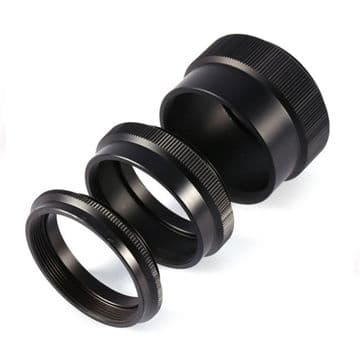A popular microscope objective of the finest quality. 50x Plan APOchromatic, Infinity Corrected, Long Working Distance 20.1mm. NA 0.42. F:200mm. FOV Object 95mm Parfocal length, Infinity Optical System. M26 Thread. Weight 230g. Flat, chromatic aberration free, large field of view.
The exact appearance and specification of the objective may vary as we source these from different manufacturers over time but the fundamentals will be maintained or improved.
OBJECTIVE MICRO PHOTOGRAPHY
Attaching microscope objectives (lenses) direct to your DSLR camera using special objective tube kits. Essentially you are building your own microscope. To do this you take an objective that is normally found on a biological or materials upright or inverted microscope and attach it to your DSLR camera in one of two ways:
Attach to the end of your telephoto lens. To do this you need a 42mm:objective thread adapter. Most objectives have what is known as an RMS thread, others have M26 threads and very occasionally other size threads. So you will need the correct M42 adapter. For this method, ideally you will need an infinity corrected objective (see below).
Attach to an M42 Extension Tube Set. This set starts with a bayonet mount:M42 adapter that is specific to your camera. Then there are a number of extension tubes so you have the correct length. Finally you will need the 42mm:objective thread adapter outline above. The exact length of the tube set depends on the 'tube length' stated on your microscope objective, this will require some experimentation to optimise. Please see below:


About Objectives
MAGNIFICATION
Lower magnification objectives below 4X , counter-intuitively, usually cost much more than high magnification ones, this is because they are rarer and require a lot of engineering to work well on a microscope. Lower magnification objectives, as in macro photography, are always easier to use as they generally have a longer working distance.
QUALITY OF OBJECTIVES
The quality of the optics hugely influences prices as you would expect. In order of increasing quality these are the choices in quality, ranked from best at top:
PLAN APOchromatic
Semi PLAN APOchromatic - sometimes also called PLAN FLUORITE
PLAN achromatic
Semi or Economy PLAN achromatic
Achromatic
WORKING DISTANCE
This is the distance from the end of the objective lens to the point on the subject that is in focus.
You should be aware that the higher the quality of the objective, the shorter is the working distance. Therefore to make long working distance versions of very high quality objectives is a very difficult task which increases the price hugely.
Certain classes of microscope onto which objectives are designed to be mounted require a long working distance, these tend to be inverted microscopes and some materials/metallurgical microscopes. It is not a bad idea to seek out these objectives but they will cost more.
You can increase the 'native working distance of an objective by introducing an M42 Iris, in exactly the same way as an iris is used in macro photography. Closing the iris to increase working distance requires more light of course and the image quality will degrade.
SPECIAL OBJECTIVES
There are a host of different types. Here are some common examples:
Long Working Distance - inverted microscopes and some materials/metallurgical microscopes use these.
Coverslip Corrected - these objectives typically have 0.17 written on them. They are specially corrected for looking through a coverslip (coverglass) with a thickness of 0.17mm which is placed over a specimen on a glass slide. Sometimes they have a different coverslip correction value. Best to avoid objectives with this written on them if possible unless, of course, you are using a coverslip. It is not a disaster to use objectives up to a magnification of 20X without a coverslip on your specimen, beyond that magnification the image degrades increasingly.
FL - these are usually fluorescence grade objectives and may even be Plan Fluorites, they are designed to allow the transmission of a wider range of wavelengths. They are generally very good for photography.
PH/PHP Phase Contrast, these are designed with an annulus built into them which is supposed be aligned with corresponding disks in a biological upright's phase contrast objective to give a particular contrast enhancing effect on 'gelatinous' subjects that otherwise may be substantially transparent. These objectives also work as normal 'brightfield' objectives and are fine for photography.
DIC Differential Interference Contrast, these are similar to phase objectives but use a polarising special effect. They are usually high quality objectives and are very good for photography.
Customer reviews
| Brand | GX Microscopes |
| Condition | New |
| Product Code | UM1028C |
| Weight | 0.4kg |

-43-p.jpg?w=121&h=121&v=ae7ffe0a-44ae-44f8-9a65-532fb1e560d1)




